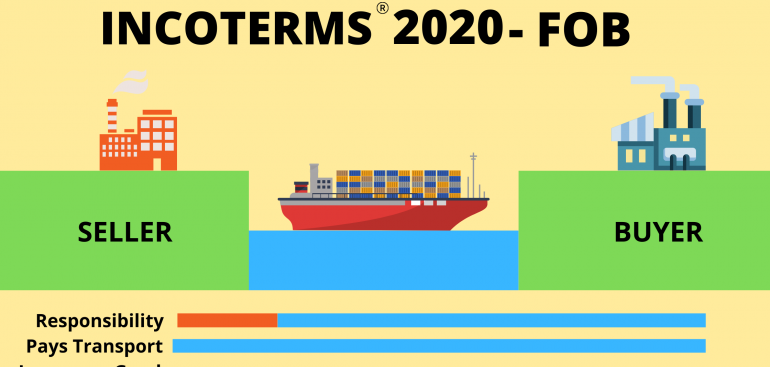What is a FOB? means Free on Board where the seller pays for transportation to a named port of exit (named by the buyer) from his factory or other places of business which will be selected by the buyer. Cost & Freight – CIF: The seller pays for transportation to a named port of destination (named by the buyer). The seller must contract for insurance during transit. Cost, Insurance & Freight – CFR: The seller pays for transportation and also assumes all risks up to the destination.
This incoterm’s unit cost is called FOB price. FOB price is used to calculate CIF and CFR prices. Let’s explain with simple equations.
FOB price + Freight value = CFR price
CIF price = FOB price + Freight Value + Insurance Value
Let us get into the subject a bit deeper to understand what is an FOB and what the contract looks like.
The seller will give a quotation at the negotiation time according to the buyer’s requirements. Let’s say that buyer requested a quote for the CFR price. The seller provided the quotation accordingly. The buyer found the price too high so they asked for a revised quote with the FOB price. The buyer will now compare the quotes and attempt to determine hidden freight costs in CFR price.
Example
Let’s say the commodity is wheat. The seller offered $1000 per metric ton with CFR delivery terms.
POL: Mundra port, India
POD: Jebel Ali port, Dubai
In such cases, delivery terms will be specified in the contract: CFR Dubai.
The seller will be quoted for the second time as per the buyer’s request, where the seller will be quoting for $800/ton FOB.
In such cases, delivery terms will be specified in the contract: FOB Mundra
We can see that $200 ($1000-$800 per metric ton) is lower when the incoterm is changed from CFR to FOB. This $200 could be considered Freight cost.
The buyer must calculate the freight cost of goods to export.
Let’s say that total wheat production is 20 metric tons. Then total freight cost per seller’s quote will be 20x$200=$4000.
The buyer will now approach local vessel/carrier agents in Dubai to request a quote for ocean freight from Mundra (India) to Jebel Ali (Dubai). Assume they were given a $2000 quote for 20 metric tons of Wheat. This is the lowest ocean freight.
Thus buyers will save $2000 if they arrange transportation and execute the deal under FOB terms.
Let us see what the best way to workout,
CFR price was $1000/metric ton. Therefore, 20 metric tons will cost $20000 (20x$1000).
If they choose FOB, the total cost would be $16000 (20x$8000), while ocean freight costs $2000. The total cost of FOB will be $18000 (16000+$2000).
Total Savings: $20000-$18000= 2000
(If insurance is required the same calculation will be applied for CIF.)
If buyers have good connections with vessel owners or agents, we can see that they can obtain competitive ocean freight rates and insurance costs. They can also save money by choosing FOB contracts.
As in the above example, if the seller and buyer agree on FOB terms, the buyer places a purchase order. The FOB contract is then finalized for international trading of the commodity.
Operations:
Once the deal is secured, the seller begins production. After the finished goods have been prepared, they give the buyer the information. In some cases, the latest cargo readiness date may be finalized at the time of contract closing. The seller then makes the goods available by the agreed date.
After goods have been manufactured, the seller will pack them according to the agreement.
During this time, the buyer contacts the vessel agent or owner to book. Once space has been booked, the buyer will send the contact information of the local vessel agent to the seller. The seller will then approach the agent at the loading point to arrange for goods to be loaded onto the vessel. Customs clearance at the port is done at the seller’s expense.
After onboarding, the seller sends all documents necessary to ship the goods to the buyer in accordance with the payment terms.
At this point, the seller is no longer responsible and the buyer takes over. Buyer contacts an insurance company to arrange for cargo insurance (marine transit insurance). Customs clearance will be arranged once the vessel arrives at the destination port.
This completes the shipment process under FOB Incoterm.
Now I hope you got a bit of an idea of what is a FOB means and how it works. If you have any consultations required for air freight, ocean freight, customs clearance, and Logistics transportation then we have a very committed team of professionals to help you out. You can get in touch with us at Consolidation Shipping Line any time of the day or drop an email at inquiry@cslindia.net
Containerized cargo is not recommended to be shipped at FOB terms.

